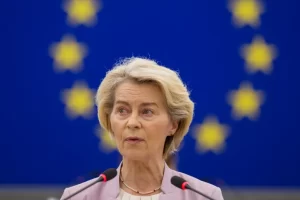The €136bn price tag on Ukraine’s path to joining the EU

Ukraine’s aspirations for EU membership face a daunting economic reality. New research puts the cost of the country joining the bloc as high as €136 billion – even before post-war reconstruction begins.
As the full-scale conflict with Russia enters its third year, the cost of rebuilding is projected to rise into hundreds of billions of euros.
But Ukraine is looking beyond the battlefield towards future membership of the European Union – and the Bruegel Institute economic think tank reported this week that Ukraine’s accession could cost current member states as much as €136 billion.
Although the sum is only a fraction of a percentage of the European Union’s GDP, it still represents a considerable portion of the bloc’s seven-year budget.
The process of Ukraine’s integration into the European Union began at breakneck speed after Russia’s invasion in February 2022.
By June of that year, the EU signalled its commitment to Kyiv by swiftly approving its membership application, granting Ukraine official candidate status.
However, the European Council stipulated further reforms – particularly in the realm of rule of law and governance – as prerequisites for accession negotiations, amid criticism that the bloc was being too hasty in pushing for Ukraine’s membership.
Those prerequisites were finally agreed upon last December, following months of vetoes and political grandstanding by Hungary’s pro-Russia prime minister, Viktor Orban.
Hungary blocks billion-euro EU aid deal for Ukraine Public-private investment
If and when EU accession comes to pass, what assistance must Europe provide Ukraine in managing post-war reconstruction, and at what cost?
Reconstruction costs for Ukraine are estimated at around €400 billion, “which is a huge amount”, says Zsolt Darvas, senior fellow at the Bruegel Institute and co-author of its report.
“But it’s not the EU who will pay for most of that,” he explains.
According to the economist, the European Union would contribute to rebuilding key assets not only through public funding but also via private companies, “thereby gaining ownership of a large share of infrastructure in Ukraine”.
“The private sector will contribute, the EU will contribute … as will other countries, [but] it also depends on who will be the next US president,” notes Darvas.
“At this stage, it’s impossible to break down how this €400 billion will be distributed between different actors.”
Hard sell for Brussels
How such a hefty price tag would wash with EU member states is hard to predict, with many right-wing parties already bemoaning Europe’s “over-expansion” into Eastern Europe.
“How will EU member states swallow this? That’s a big question and certainly a political question,” Darvas tells Newswire.
He stresses that the real costs could end up being less than his institute’s projection, which is based on several suppositions.
“First of all, it assumes that Ukraine will regain its full territorial integrity – that its GDP and population will not be permanently impacted by the war.
“If some territories remain under Russian control – with the GDP and population permanently reduced due to the war – then this number is going to be going to be lower,” he explains.
The analyst also notes that trade and foreign direct investment will become easier if Ukraine becomes an EU member, pointing out that Western companies “made huge profits” when central European states joined in 2004.
EU heading for ‘small revolution’ on enlargement: French minister Combatting corruption Yet with an influx of new money comes the spectre of corruption.
For Darvas, the biggest challenge is Ukraine itself – namely, the rule of law, democracy and controlling graft.
“If you look at the indicators, Ukraine ranks very poorly on all these dimensions,” he says.
According to governance indicators compiled by the European Bank for Reconstruction and Development, he explains, Ukraine ranks “even lower than Russia and Belarus”.
“The starting point for Ukraine is very, very weak. And it will be an enormous challenge for the country [to reach] European standards,” he told Newswire.
In other countries, the accession process has proven to be a powerful driver of fundamental reforms. But Darvas emphasises that there is a long and challenging road ahead for Ukraine.
What is ‘multi-speed Europe’, and does France back the idea?
Europe’s poor relation
Nevertheless, Russia’s invasion has catalysed a scramble within the EU to get Ukraine on board, no matter the cost.
Some have drawn a parallel with the reunification of Germany in the early 1990s, which is estimated to have cost some €2 trillion over 25 years as the wealthier West poured investment into the formerly Soviet-controlled East.
At the time, the main goal was to bring the living standards of East Germans close to those of West Germans, Darvas explains.
“While wages still remained somewhat below what was in West Germany, that gap was 20 percent or so. In the case of Ukraine, we’re talking about wage differences of more than 10 times or 15 times,” he points out.
He does not believe Brussels will shell out to bring Ukraine’s wage levels closer to the EU average: “That would be an enormous cost.”
What is more likely, Darvas suggests, is that Kyiv will start navigating “convergence paths towards the EU” that will put Ukraine’s economy on a trajectory towards better wages and living standards – although it will be a long haul.
“Since the starting position of Ukraine is very, very low in terms of income and GDP per capita, I’m afraid that even after many decades, it will still remain the poorest member of the European Union,” he says.





